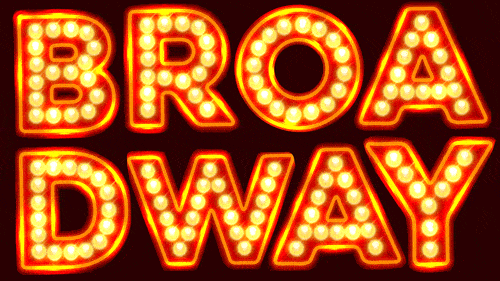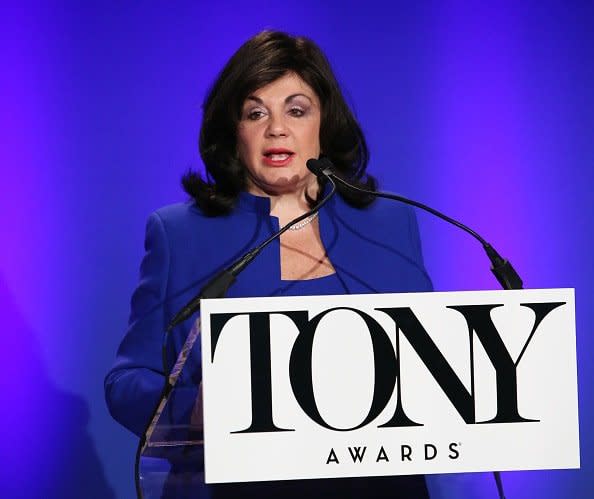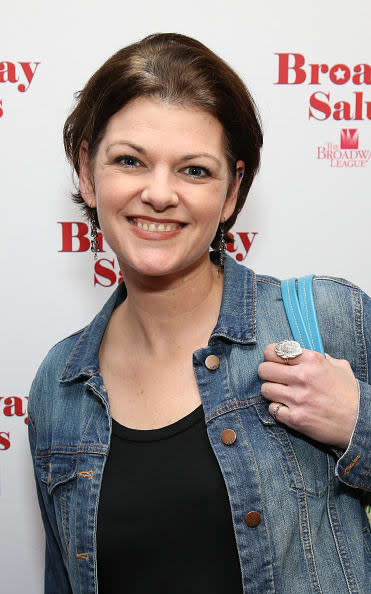Broadway Loves a Comeback. A Year Since It Closed, Its Own Might Be Tough.

The Broadway opening night of Six, the propulsive pop musical focusing on the lives of the wives of Henry VIII, was due to happen a year ago tonight. It was the last Broadway show this reporter saw, the theater at that Saturday afternoon matinee already not full, and audience members noticeably nervous. Six didn’t open on March 12, 2020. Instead, Broadway, under the order of New York Governor Andrew Cuomo, went dark. Everything shut. Nothing has been performed in the 365 days since.
If, as is now hoped, theaters reopen in the fall, Charlotte St. Martin, president of the Broadway League—the national trade association for the Broadway industry, which oversees 41 theaters—estimates that lost revenues will amount to $3 billion in ticket sales, and $22 billion when it comes to the wider economic impact on New York City.
Theater Imagines its Post-COVID Future, Including a Socially Distanced ‘Mrs. Doubtfire’ on Broadway
“Reopening Broadway is going to be ten times harder than shutting down,” Kate Shindle, president of Actors Equity Association (“Equity”), which represents more than 51,000 actors and stage managers, told The Daily Beast.
Even the fall reopening date may be eyed gingerly. As the pandemic has continued, possible Broadway reopening dates have been floated, then passed unmet. The shutdown has affected not just Broadway, but off-Broadway, off-off Broadway, and theaters and orchestras and performance spaces nationwide—and all the hotels, bars, shops, and restaurants whose income relies on theatergoers.
The impact on lives and livelihoods of those working in—and orbiting—the arts has been severe, which made the passing of the $1.9 trillion American Rescue Plan this week so critical. As Playbill reported, the bill allocates $135 million each in supplemental funding to the National Endowment for the Arts and National Endowment for the Humanities. The grants will go to organizations “to prevent, prepare for, respond to, and recover from the coronavirus.”
Another $1.25 billion will help owners of previously shuttered theaters, under the Economic Aid to Hard-Hit Small Businesses, Nonprofits, and Venues Act.
Union members have also seen their COBRA subsidy extended through Sept. 30. The subsidy was particularly important, Shindle told The Daily Beast, as Equity actors have a work week-based health insurance program, which members only qualify for when a certain number of weeks of work have been accumulated. “It doesn’t take a ‘math-lete’ to understand that if you’re not working at all there is a very good chance you will fall off health insurance,” Shindle said. “The COBRA subsidy will help those with very little income from ‘survival jobs’ they also rely on that also went up in smoke.”
But, Shindle added, the pandemic had delivered other “stark” lessons—primarily that while the subsidy was welcome, the financial peril faced by so many highlighted the need for a federal health insurance plan.
As theaters plan reopening—more positively now, given the ongoing vaccine rollout—questions remain over their immediate financial viability and safety for audiences, performers, and crew. There is also a taking stock of the last year, including—following the social and cultural reckoning following George Floyd’s death—ensuring that Black representation on and off stage is fully, practically recognized when theatrical life resumes.
St. Martin told The Daily Beast: “A lot of people have spent the last year without any revenue, any income, many without health insurance and certain protections. Lots of dreams and heartbreak came together at the same time. The theater is more than just making money for everyone, it’s a life’s passion. It has been a traumatic time, seeing all these shows not able to open, wondering if they will ever get to open, and seeing all the pain and suffering.”
The illness and death of Broadway actor Nick Cordero garnered considerable media coverage; and many others in the Broadway community experienced COVID directly, or via the experiences of loved ones. As The Daily Beast reported, leading designer Edward Pierce came close to death—then made medical history. Successful activism led Congress in December to pass the Save Our Stages Act.
Shindle told The Daily Beast: “If anybody had told you a year ago that this would go on this long, they would either have to have been psychic or incredibly pessimistic. In general, I don’t think anyone imagined it would continue for this much time. Like many people, I have not had a paycheck in a year. I am a working actor. Unlike many other people, I am fortunate enough to have savings and a little house, for which I am incredibly grateful. I think that is why I was so emotional watching President Biden sign the legislation this week.”
Shindle said, within Equity at least, the formation of a “new normal” had been discussed, “where we don’t carry on doing a show if we are sick or injured, where Black actors and stage managers are not locked out of access as they have been and which has been made very, very clear over the last year. And we need a ‘new normal’ of more arts funding, so some of these problems can be addressed more easily.”
What Shindle had heard most from members this was past year was “fear”—with people now out-of-work having to leave their home cities, or considering leaving the profession entirely. Members who had found some work had sometimes had to negotiate safety protocols that did not seem that safe, Shindle said—a critical matter when long-term lung damage can finish careers, and potentially also for those who have come into contact with the affected person and who became infected themselves.

Charlotte St. Martin.
St. Martin said she has been “cautiously optimistic” since Dr. Anthony Fauci, director of the National Institute of Allergy and Infectious Diseases, said he thought theaters could open “sometime in the fall,” depending on vaccine rollout, and good air filters, and ventilation in theaters. Audience members will likely still have to wear masks, Dr. Fauci said, foreseeing theaters able to open to capacity audiences this autumn.
St. Martin said she echoed Dr. Fauci, in hoping theaters would reopen in the fall; some shows are already slated for a September opening, while more cautious others are going for October, she said. “At this point, it really comes down to science, and how we’re doing when it comes to keeping COVID numbers down.”
As she told The Daily Beast last year, St. Martin does not foresee Broadway theaters opening with less seats or social distancing. “If we are sitting here a year from now and it’s the same, that may change. We’d have to make a new financial model for Broadway to survive.”
But St. Martin hopes, like Fauci, Broadway will find a way to fully reopen and instill enough confidence and a feeling of safety for performers and audience alike to aspire to business as usual.
St. Martin told The Daily Beast that the League’s five “protocol task forces” focusing on all aspects of how theaters work for audiences, performers and backstage crew was formulating new rules for all aspects of the theater-going and working experience, with the aid of an infectious disease specialist.
Broadway’s many unions—including Equity, the International Alliance of Theatrical Stage Employees (IATSE), the American Federation of Musicians (AFM), and the Stage Directors and Choreographers Society—are also focused on ensuring their members’ safety and security.
An emerging critical issue was pay, said Shindle. She has heard of theaters seeking a salary reduction in their bargaining agreements with staff and performers in order to reopen. In December, the Metropolitan Opera “locked out” stagehands after contract talks stalled. “This is not an easy conversation,” said Shindle. “It’s a balancing act between how much people want to get back to work, versus reopening shows without people being fairly compensated.”
Money will be a thorny issue all round. Pre-pandemic, Broadway houses broke even with around 94 per cent of seats filled. If they reopen with even 75 to 80 per cent of seats filled, St. Martin said, shows will ultimately close. “The running costs are so dramatic. Also, very few shows will have the resources to stay open, especially after being closed for 18 months with all of their advances used up, and attempting to keep their cast together, and paying all their expenses.”
Audiences should expect to be seated next to one another just as before, though masked. St. Martin said cast and crew will likely have access to rapid testing, but not audiences. “We don’t think it’s realistic that we could get, at least right now, 1,500-2,000 people rapidly tested and have any part of their day left over to see a show. So, there has to be other solutions, and we think there’s a very good possibility there will be.”
St. Martin said this may mean presenting proof at the theater, perhaps in passport form, of having received a full vaccine, or a recent negative COVID test result.
“We haven’t decided anything yet,” she said, “but I’ve said from day one I think that would make a lot of sense, unless they come up with a test that is immediate. I just don’t know how you test 1,500 people, which is the average size of our theaters.”
“It’s very likely actors will wear masks in the wings, and take them off to do their scenes.”
The tough truth, at least right now, as Shindle said, is that no-one is exactly sure what the return of Broadway will look like. Will there be large, pre-pandemic successful shows who try to open up with their full contingent? Will there be a smaller cast shows, with a movie star leading the production for 13 weeks?
The availability of vaccines, and the provision of masks, gloves, and protective equipment will be important factors in governing how safe Equity members feel returning to work, said Shindle. “It’s very likely actors will wear masks in the wings, take them off to do their scenes, and put them on again after they exit,” she said. “I think there’s way to make it work. A lot of the theaters are historical landmarks, and it’s probably prohibitively expensive to make major renovations, apart from dealing with ventilation and a number of air changes to make everyone safe in the building.”
As well as audience members wearing masks, there would be “many contactless services,” when it came to tickets and concessions, St. Martin said. Entering and leaving theaters may be conceived in new ways, and the League was still trying to figure out what to do about intermissions when Broadway theaters become clogged with people going to get drinks and snacks, heading to the restrooms in snaking close-contact queues, and stretching their legs.
St. Martin said one pre-pandemic trend—for shorter 90 or 100-minute shows, without intermissions—could help solve this in the immediate term. She does not think epic, multi-part shows, like The Inheritance, will happen “until we get a handle on COVID.”

Kate Shindle.
The safety of arts workers as the first green shoots of performance return is paramount for Equity. It recently asked its members to check in with the union if they were approached to take part in the city’s new Open Culture program, because Equity claimed the program did not meet the union’s wage and safety standards.
In relation to the planned “PopsUp” performance program, Equity asked Governor Cuomo to consider vaccinating arts workers.
Shindle said, “I care if performers are being asked to work, and not getting tested in advance. We all want the New York economy to rebound, but the last thing anyone needs is holding live performances to show that New York is back and then have a lot of people get sick from it. What message does that send?”
A grave problem may be under-employment, if post-pandemic productions start small, with fewer cast members and crew.
“That is a fear of a lot of people,” said Shindle. Equity represents stage members, principal actors, and chorus actors. Principal actors may be on “safer ground,” said Shindle, but if employers say a smaller show requires half the number of chorus members and a lesser need for stage managers, it could lead to many people being out of work. “I know these are numbers on a page in some respect to people crunching numbers, but to us these are people with lives, who are already suffering and need to work,” said Shindle.
Many Equity members were “dying to get back to the rehearsal room and stage,” Shindle said, playing to audiences of any size, with the gung-ho attitude that if they get sick they can recover. “But that’s problematic because it leaves behind our members who are senior citizens, or who have underlying health conditions.”
Some others would feel safer with social distancing, Shindle said, even if a busy stage with actors interacting with one another is one of the reasons audiences to the theater. “My expectation is that the first shows back maybe have some accommodations for as much distancing as possible, and then, as we gradually get to herd immunity, things start to look a lot like they did before.”
St. Martin accepted there was “not a lot of room” in backstage areas, and—given the age and layout of the buildings—redesigning them might not be practical. This again was something the League was seeking scientific advice on.
St. Martin said each of the 41 theaters under the aegis of the League are so individual as to require their own plans: “Many are over 100 years old, none are like the other.”
One of the biggest challenges is air conditioning and filtration, and updating antiquated systems that will not be fit for purpose post-pandemic. These new systems will have to be installed before any reopening is formalized, St. Martin said. “One place where the government and Broadway have exactly the same goal is that we have to come back, and when we do, it has to be safe or we can’t open. The risk is just too great.”
“There are constant adjustments for the realities of now.”
The manner in which the green light for Broadway to reopen is given by Governor Cuomo was critical, both St. Martin and Shindle said.
“It will take six to eight weeks for shows to get up and running,” said St. Martin. “Up to now he’s given very short notice to reopen to restaurants, for example, one or two weeks. We can’t do that. Casts and crew are scattered all over the world. Shows would need to go into rehearsal, even if some of the longer-running shows’ companies may have the muscle memory to come back sooner. The other important consideration is to give shows enough time to sell tickets, so that when they re-open they can cover their running costs and they don’t have to close right away.”
St. Martin is hopeful that some of the money allotted to the Economic Aid to Hard-Hit Small Businesses, Nonprofits, and Venues Act, may help keep shows from hemorrhaging money, especially if shows cannot immediately attract a 94 per cent-full house.
Another key concern is attracting tourists back to New York City—and its theaters. The tourist audience accounts for around 65 per cent of a typical Broadway house, with Tri-state attendance at around 35-40 per cent. St. Martin said it was “absolutely” critical that the governor says New York is open for business as usual before theaters reopen.
When it comes to a Broadway reopening masterplan, Shindle said nothing had been fully finalized or solved yet: “There are constant adjustments for the realities of now,” she said. All parties, it seems, are trying to guess the reality of a future they don’t yet know. Like St. Martin, Shindle said “a proper lead-in time” was essential, so Broadway could reopen properly, to factor in rehearsal time, technical issues, costume fittings, and vaccinations.
When this reporter asked Shindle how in tune a union like Equity was with the Broadway League, she joked, “I could tell you, but I’d have to kill you.” One senses all sides of the Broadway equation want the same thing, but getting there—ensuring the safety of performers, crew, and audiences alike—will take some hard, and perhaps contested, evaluation.
Ultimately, Broadway will reopen when audiences, actors, technical crew, and theater staff feel safe enough to be in a large, indoor space, filled with people. Both St. Martin and Shindle hope this is soon, even if the experiences of the last catastrophic year have made them circumspect about making any grand predictions and promises. For both, some kind of end feels in sight.
“I think that Dr. Fauci is part of the reason I am cautiously optimistic about the Fall,” said St. Martin. “I don’t think he is subject to exaggeration. If he feels it is a good possibility I’m going to go with his feeling. Just the number of people getting vaccinated and the lower incidences of COVID in the city is a reason for optimism,” she said.
“Thank God, it’s feeling like we’re coming out the other side of it,” said Shindle.
Get our top stories in your inbox every day. Sign up now!
Daily Beast Membership: Beast Inside goes deeper on the stories that matter to you. Learn more.
